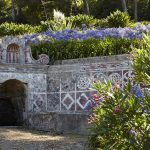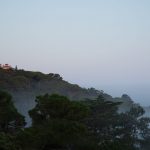The discovery of a Paradise on Earth…and Xintara.
One of the first things people ask us is where does the name Xintara come from. The name –‘Xintara’ (pronounced Zintara) actually comes from the old Moorish name for Sintra, which is the unique and magical place where we hold our retreats. Sintra is located only 30km north of Lisbon, and roughly halfway up the coastline of Portugal.
Sintra is a beautiful UNESCO World Heritage protected mountain range or ‘Serra’ which is largely populated by forests, adjacent to the Atlantic coast and studded with unique historic properties, palaces and gardens.
Long ago in the 9th Century, the Moors arrived in Portugal from the hot dry deserts of North Africa. They quickly identified the cool forested mountain range and clear springs of Sintra as an earthly paradise in which to build their palaces and castles. The moors brought with them an advanced civilisation, fruit such as oranges and pears, and sophisticated cultivation and irrigation techniques.
The Moors stayed in Portugal for nearly 500 years until the mid-15th Century and therefore strongly influencing the cuisine (check out the delicious and refined ‘Queijadas’ cakes of Sintra) as well as the art and design (as can be seen in the beautiful and abstract decorative wall tiles -‘Azulejos’ of Sintra Palace).
In the Islamic tradition, a garden combines the key elements of water, the scent of fruit trees, and places for rest and reflection, in order to celebrate heaven on earth.
Paradise gardens play a central role in everyday life in the Islamic world and whilst Sintra does not have a comparable to the superb Alhambra Palace in Granada, Spain, it does have an Arabesque Palacio de Monserrate and its botanical gardens located right next to Quinta Sao Bento where Xintara retreats are held. When it comes to the Monserrate gardens, it may have more of a free-flowing English garden influence than a structured Islamic one, but it does have long water basins overflowing with carp and an ornate sculptured Islamic-style palace, used in films such as the 2016 feature film Promise with lead actor Christian Bale to depict a palace in Istanbul.
A retreat from the world to a rural paradise was exemplified by the Roman lyric poet Horace who lived during the reign of the Roman Emperor Augustus and wrote his famous odes from his beloved farm in the Sabine hills near Rome in 23 BC. Horace’s poem Ode XI introduced the term ‘Carpe Diem’ – often translated as ‘sieze the day’ and made internationally well-known through the film Dead Poets Society. Was Horace therefore maybe the earliest champion of the modern well-being retreat- recognizing the need to find a refuge in nature in order to reconnect with knowing how to live a full life?
Many centuries after Horace, another Islamic poet followed a similar Horatian tone, this time celebrating the delights of Sintra. Ibn Mucana was a poet who lived in the first part of the 11th Century during the Moorish legacy in Portugal. When not engaged in flights of literary fancy, Mucana was mayor of Lisbon and specialised in eulogies and flourishing outpourings, including an ode to Alcabideche, nestling in the hills of Sintra.
Mucana’s poem begins by asking that citizen-farmers of that village never lack grain or onions or pumpkins. There is a clear Horatian tone to the poem, celebrating the delights of Colares, located down the valley from Xintara. The poet speaks of a quiet freedom which the tillers of the land, happy in the work, enjoy above the easier but less rewarding lifestyle of their urban cousins. Ibn Mucana is said to have recited his poem to a friend en plen air while oxen were ploughing a nearby field.
Should you want to develop your own poetic musings, and if in season, you may find your own pumpkins and onions in the Xintara gardens, alongside the runner beans, peppers, aubergines, tomatoes, lettuce and courgettes. We have yet however to introduce any oxen.





